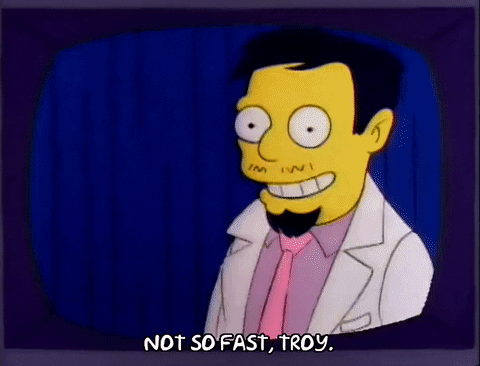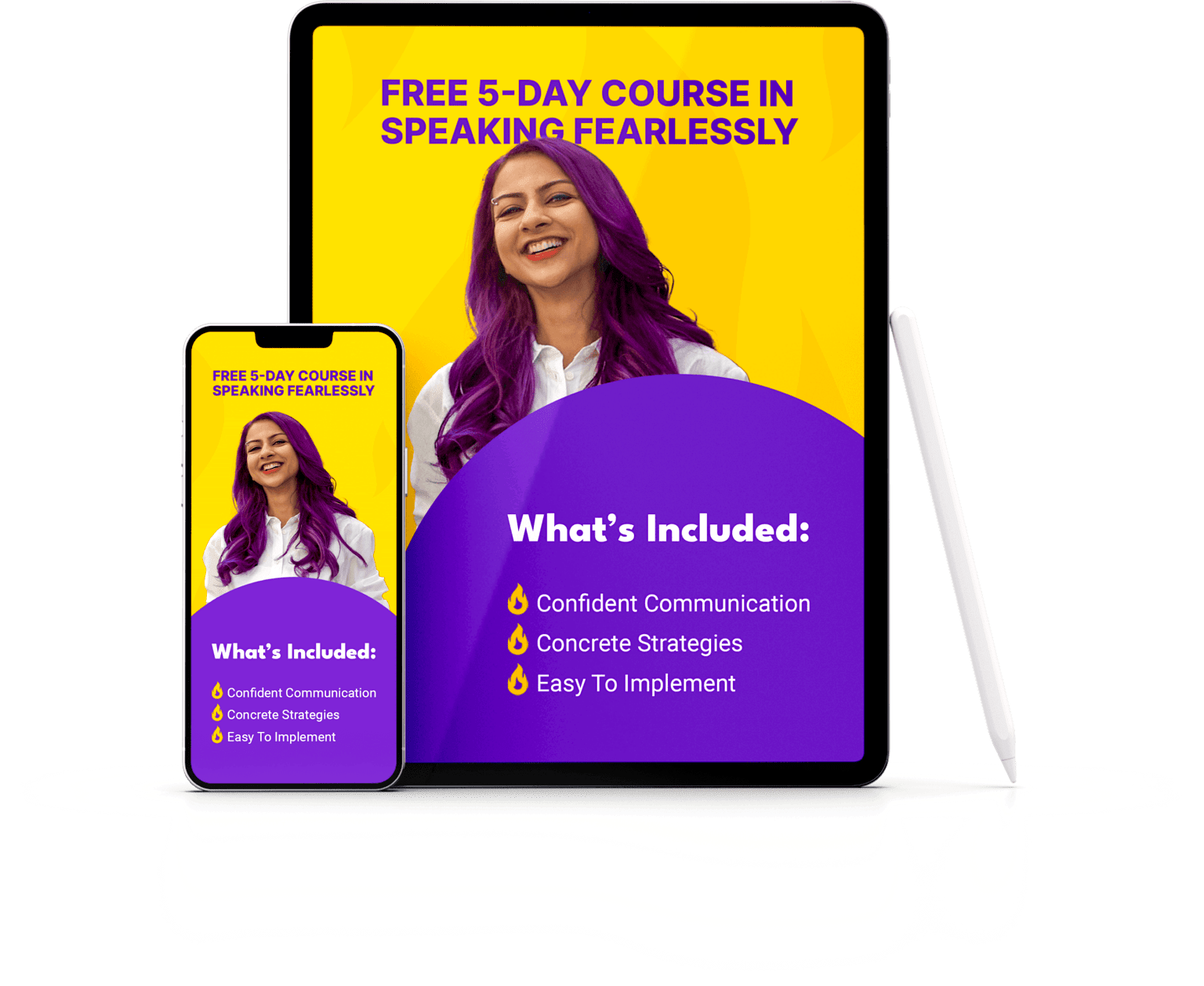Do you find yourself speaking too fast but don’t know how to stop or gain back control?
You’re not alone – a majority of my clients experience this challenge.
Slowing down isn’t just about avoiding nervous rambling- it’s the key to unlocking powerful communication by intentionally varying the speed at which you speak.

ImageCredit: Photo by freepik
In this article, I‘m going to share with you tried-and-tested techniques to be in control of your pace when you talk so that you can become a powerful speaker on any stage or screen.
What’s inside:
Why do we speak too fast?
Most people speak too fast in one of these two scenarios:
- When they’re nervous – their hearts are beating super fast and they just want to get done speaking as soon as possible.
- When they’re passionate about the topic – they can’t hold themselves back and want to share as much as they can.
The common thread here? In both scenarios, you’re not speaking fast intentionally – and even when you become aware of it, you may not be able to slow down.

Credit: Image by Giphy
The solution is straightforward. It starts with developing the right mindset and following it up with specific techniques to practice. I’ll share four techniques each for developing the right mindset and practicing variation of pace, so you can feel confident and create a lasting impact on your audience.
Mindset-based techniques to control and vary your speed of speaking
1. Cognitive Restructuring
This is a form of cognitive-behavioral therapy (CBT) developed by psychologist Albert Ellis to help people deal with anxious behavior.
The idea is simple: our emotions and behaviors are primarily determined by our thoughts, rather than by external events. You can change your emotions and behavior by identifying and changing the “irrational” thoughts that lead to them.
Here’s how you can implement this technique:
Step 1. Challenge your anxiety that leads to rapid speech.

Credit: Image by Giphy
Be aware of yourself when you begin to speak too fast – identify the thoughts racing in your mind.
They could be “demanding” thoughts such as “I shouldn’t make any mistakes”, or “awful” thoughts such as “It’s going to be terrible if I can’t speak well today” or even “catastrophizing” thoughts such as “If I fail today, I’m a complete failure”.
It’s okay – once you catch yourself thinking these thoughts, you’re halfway to finding a solution.
Step 2. Replace anxious thoughts with more logical ones

Credit: Image by Giphy
Here’s how you can change that internal narrative:
- Instead of “I shouldn’t make any mistakes”, think “Everyone makes mistakes. It’s a normal part of learning and growing”.
- Instead of “It’s going to be terrible if I can’t speak well today”, think “It’s not ideal if I don’t speak as well as I’d like, but it won’t be a disaster. My audience is here to learn and engage, not judge my every word.”
- Instead of “If I fail today, I’m a complete failure”, think “Failing doesn’t mean I’m a failure. It’s an opportunity to learn and improve.”
It’s important to understand that we are not talking about overly optimistic or having unrealistic thoughts here. We’re talking about inducing rational positive thoughts.
You’re not trying to suppress the negative thoughts either – that doesn’t work. Instead, acknowledge the negative thoughts and gently replace them with more helpful ones.
2. Behavior Modification
When you speak too fast, your words may not express your ideas well enough before you move on to the next thought, and the one after that.
This happens because your thoughts and words are not in sync. As the speed of your thoughts outruns the speed at which you speak, you begin to speak faster. You think: “Gotta cram this all in before I forget”.
The key is to de-link your thoughts with your speech intentionally.
Step 1. Become aware of your speed of speech.
Become more and more conscious of how fast you’re speaking in the moment.
Step 2. De-link it from your speed of thought.

Credit: Image by Giphy
De-linking on the fly comes with practice. Here are a few exercises you can use:
a) Dissociation exercise
As you practice a talk, watch your mental chatter without getting carried away – like a fast-moving stream you’re calmly observing, not swimming in.
Now, you can focus on bodily sensations like breath or temperature. Anchor yourself in the present and detach yourself from these racing thoughts. Observing thoughts without judgment weakens their control over your actions.
The best way to practice this is to use it whenever you talk to someone.
b) Pause exercise
With this technique, you’ll use the pause as a powerful tool.
You can pause before and after stating an important point. This gives your audience time to absorb what you said, and you get time to choose your words more deliberately.
To enable you to do this, intentionally speak at a slower pace than your natural speed of thinking. It takes conscious effort but becomes second nature with practice.
Step 3. Create an intentional filter.

Credit: Image by Giphy
Filter in thoughts that align with your goal. Filter out tangential thoughts, anecdotes or jokes that may distract people from the core message.
When you speak with intention: less is more.
Creating this filter lets your thoughts race but allows you to decide which ones to express.
3. Mindfulness (the Kabat-Zinn way)

Credit: Image by Giphy
You can reduce the pace at which you speak by becoming mindful and bringing your awareness to the present moment.
Step 1. Focus on your breath and physical sensations while speaking.
You can start by practicing deep and rhythmic breathing to calm your nerves and anchor yourself in the present before and during the talk.
As you do this, notice the feeling of your diaphragm expanding, the vibration of your vocal cords and the movement of your lips as you speak. As your focus moves to your breath and physical sensations, you may find that you’re not obsessing over your thoughts as much as before.
Step 2. Observe the audience’s reactions.
The best way to do this is to pay attention to the subtle non-verbal cues your audience is giving you. Check if they’re nodding in agreement or leaning in with interest. Focusing on your audience makes you slow down and gain control of your speed of talking.
When you’re in control of your pace you’re perceived as confident, reliable and trustworthy.
4. Systematic Desensitization
Joseph Wolpe developed a technique called systematic desensitization to treat anxiety and phobias. It works by gradually exposing a person to their fear in a controlled way, paired with relaxation techniques.
Here’s how you can implement this technique to avoid the anxiety that’s leading you to speak fast:
Step 1. Create a hierarchy of speaking events for gradual exposure
You’re used to feeling anxiety and fear in the spotlight. Instead of subjecting yourself to a high-stakes talk, ease into being in the spotlight:
Here are some low-stakes, low-anxiety speaking opportunities you can build on:
- Delivering a 1-minute talk alone in your room: Practice delivering your presentation when you’re by yourself, focusing on clarity, conciseness and your body language.
- Role-playing with a trusted friend or a speaking coach: Simulate different speaking situations and practice responding to questions.
- Asking questions during another presentation: Aim to raise your hand and ask in the next town hall meeting or the next live event that you attend.
- Delivering presentations to small groups of familiar people: Begin with family or close friends who will be supportive and understanding.
Moderate anxiety speaking situations:
- Joining public speaking clubs or Toastmasters groups: Practice in a supportive environment with people who share your goals.
- Networking events or meetups: Introduce yourself to new people and discuss topics of interest in a less formal setting.
- Presenting at work meetings or conferences: Volunteer to present at smaller meetings or internal presentations before tackling larger audiences.
High anxiety speaking situations:
- Giving a keynote presentation: Aim for this level only after mastering smaller situations and with emotional and coaching support.
- Speaking on live events or podcasts: This exposes you to unpredictable questions and requires on-the-spot composure.
I’d recommend building your own hierarchy of speaking situations that feel manageable and then progressing slowly to avoid overwhelming yourself. Also, it’s crucial to celebrate your progress as you go through each stage.
Step 2. Learn to relax.

Photo by Kelvin Valerio
This can be a one-minute deep-breathing exercise before you go on stage or camera, a warm-up or a “pre-gaming” routine you may have.
As you take the least anxious “stage” on your list and progress from there, you’ll be able to practice your relaxation technique and controlled pace. If you’re able to stay relaxed, move on to the next stage on the list.
Gradually work your way up the hierarchy, always pairing relaxation and controlled speed of speech.
Practical techniques to pace your talk better
Now that we’ve seen the techniques to enable the right mindset shift for speaking at a controlled pace, let’s look at a few practical techniques to vary the speed at which you speak.
1. 3-step gear shift
When you speak fast throughout the talk, it’s like you’re a car in 4th gear at all times. Aim to start in first gear (at a lower speed) and keep shifting those gears based on the traffic conditions (how closely the audience is following you) and road conditions (what you want to say).

Credit: Image by Giphy
Step 1. Record yourself.
Record yourself speaking or presenting and watch yourself back, watching out for instances where you’re speaking too fast.
To analyze, you can also use an AI tool to measure your words per minute.
Step 2. Practice being aware of how fast you’re speaking “in the moment”.
The more you record yourself speaking and watch it back, the more awareness you’ll build about your speech in the moment.
Step 3. Take charge!
Now that you’re aware of how fast or slow you’re speaking in the moment, take charge.
You can speed up when you want to show excitement.
Or slow down to show drama or the gravity of the situation.
2. Interrupt yourself
When you find yourself speaking too fast, catch and interrupt yourself. Use each interruption to pause, slow down and gain back control.
This will be disruptive at first but it will pay off when you get used to controlling the pace at which you speak.
3. Practice reading out aloud

Credit: Image by Giphy
Eliminate the stress of having to improvise and control your pacing at the same time. Practice reading any text out loud – and aim to focus only on controlling the pace at which you’re speaking. Intentionally add emphasis, pauses and elongate words for more rhythm. Have fun with this – treat it like an experiment to speak in a way you haven’t spoken before.
4. Enunciate
The simple act of enunciating more when you speak will slow you down and make your words and pacing more intentional.
Bonus tip: Open your mouth more when you speak – it will help you enunciate better.
Conclusion
Now you have the techniques, tools and knowledge to control your speed when you talk.

Credit: Photo by tonodiaz on Freepik
This journey to mastering your pace may seem intimidating at first, but with each step, you’ll become a more refined and compelling speaker. By implementing these techniques and practicing consistently, you’ll be able to get rid of anxiety and embrace the freedom of intentional control over how you deliver.
Start small, celebrate your progress, and watch your confidence soar as your pace becomes your most powerful ally.
Need help controlling the speed at which you speak? Reach me here.



